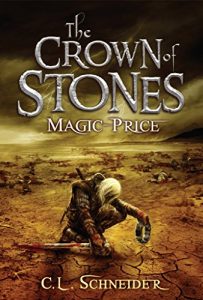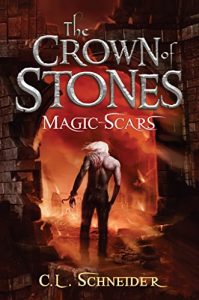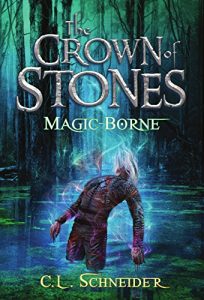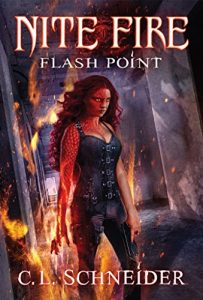Hi C.L. Schneider,
Thank you for taking the time for an interview, and welcome to my blog.
Regardless of how folks say, “You can’t judge a book by its cover,” great book covers are the first impressions for readers looking to discover new authors, and in a way, the initial handshake before gaining more insight about what’s on the inside of the book. Your incredible covers definitely snap the attention for fantasy/sci-fi readers and demand a closer look to your worlds and adventures inside. Who does your cover art?
My cover artist is Alan Dingman. Alan is a portrait artist and illustrator whose work history includes St. Martin’s Press, The NY Times, Rolling Stones, and Simon & Schuster (where he currently works) as well as privately commissioned portraits and murals. Alan illustrated Stephen King’s 3D pop-up book, The Girl Who Loved Tom Gordon. Multiple books of his design have hit the New York Times Bestseller List.
I’m lucky enough to know Alan and his family personally. We met over ten years ago when our oldest children became friends at a park. Aside from being a talented artist I admire, I consider Alan a close friend.
Covers have always been extremely important to me as a reader. When I decided to self-publish, I refused to skimp on the cover. I knew Alan had the talent I was looking for, so I approached him with my ideas for Magic-Price. I extended an offer to hire him on the side, and was thrilled when he accepted. Alan’s covers continue to be beyond my expectations.
I often tell my college English students that anyone can choose to be a writer, but usually it’s the other way around. Writing, as a profession, chooses us to become authors because we have no choice but to get the stories onto the page. Did you know at an early age that you wanted to be an author?
I’ve been writing for as long as I can remember. As a young girl, I wrote poetry and short stories (mostly murder mysteries). When my favorite characters in TV shows or movies were heading a direction I didn’t like, or didn’t dive deep enough into an area I wanted them to explore, I’d write my own script. Fan fiction wasn’t a thing at the time, but that’s basically what I was doing. I put together commercials and news reports and made my poor family sit down and listen as I sat behind a cardboard desk and ‘reported’ the news.
By the time I was sixteen, I’d abandoned my dreams of growing up to be a spy or a famous actress, and was dead-set on becoming a published author. I grew up in a family of readers, and my dad was more than happy to buy me a typewriter to pursue my dream. I sat up a card table in the living room and went to work on my first novel. I wrote in a notebook in school, when I was supposed to be paying attention, and then came home and typed at night. The result: a 600-page post-apocalyptic behemoth entitled, A Twist of Fate.
The itch to make my dream a reality was hard to ignore at that point. More than anything, I wanted to see my book on a shelf. Unfortunately, life got in the way. It wasn’t until many years later when my children were old enough to be in school full time, that I was truly able to devote myself to a writing career.
What authors influenced you the most early in life?
Some of my early literary influences were: Margaret Mitchell, C.J. Cherryh, Jennifer Roberson, Marion Zimmer Bradley, the Bronte sisters. The later influences of Jim Butcher and Simon Green, were instrumental in teaching me how to write first person.
What book are you currently reading?
I usually have several going at one time. Right now, I’m currently reading: Recreance, an epic fantasy by H.G. Chambers, A Work in Progress, a thriller by Rocky Rochford, and the 1st book in a paranormal series, The 11th Percent by T.H. Morris.
Since publishing my own book, I have read indie authors almost exclusively. It wasn’t a conscious decision really, I just discovered this whole other world of books and authors, and have had no reason to look elsewhere.
What inspired The Crown of Stones trilogy?

The Crown of Stones Trilogy was inspired almost entirely by the creation of my protagonist, Ian Troy. I was a huge reader as a child. I was lucky enough to have access to a wide variety of genres and spent many hours losing myself in story after story. In creating Ian, I set out to pay homage to some of the characters I fell in love with growing up. I wanted Ian to walk in two worlds, to be both good and bad, a cowboy and an outlaw, a hero and a monster; valiant yet broken; vulnerable enough to suffer, yet resilient and courageous enough to fight the odds. I wanted a tortured soul, a true anti-hero whose greatest strength—magic—was also his greatest weakness. As Ian’s character become more complex, the story developed around him.

My other inspiration was a chunk of amethyst that had been sitting on my bookshelf for years. I’d always wanted to write a story about a deadly magic hidden inside the stone. I knew a little about new age magic and crystal healing, and liked the idea of Ian being able to tap into and manipulate the energy inside a stone. I had a working title then: The Amethyst Crown. Once I started my research and learned more about the variety of stones and their uses, I saw a gold mine of ideas. I realized I didn’t want to limit Ian to one stone and one kind of magic. I developed an entire magic system with nine different type of magic-users and using a large variety of stones. As my magic system developed, the storyline evolved. Suddenly Ian’s entire magic-addicted race (the Shinree) were born. The crown itself grew from one stone to nine, and the title changed to The Crown of Stones.
Your descriptions for the scenes in your books are effectively visual. Please tell us about how you create such vividness?

Thank you! Writing in first person takes me deep into the minds of my characters. It allows me to step into the scene with them, to feel like I’m experiencing it as them.
I strive to wholly visualize what my characters are seeing, hearing, tasting, and smelling. By weaving those elements into the narrative and dialogue, I do my best to bring the readers into the scene with me.
You indicate that as a mother, you’re a referee to two sons. Finding time to write as a parent is often difficult. Describe your typical writing day and how much time you get to write each day.
I’m very fortunate to be able to write full-time. But, being home all day doesn’t mean I spend all that time writing. The usual housework, shopping, errands, school activities, and the like., all need to get done. If none of that is pressing, I sit down at my desk as soon as the kids leave for school. How much time I spend writing each day, versus email, promoting, working on blurbs, covers, etc., depends on what else is on my to-do list. Self-published authors wear a lot of hats. Distraction and interruption are the norm. With that in mind, on a typical day, I spend a minimum of three to four hours on my current work in progress, whether it’s writing, rewriting, or editing. Some days I sit down at 7:30 and don’t stop until it’s 2 in the afternoon and I’m starving! Other days, I’m lucky to squeeze in an hour.
When my kids were little, I learned how to write in small bursts. I couldn’t not write, so I squeezed it in; five minutes here, ten minutes there. It was incredibly frustrating at the time not to have large blocks. But it taught me how to fall in and out of a scene or a character’s head quickly. So, on the days when I do have a long list of errands or the kids are home sick, I can still squeeze something in. Even if it’s only revising a single paragraph. I’m a firm believer in writing something every day. If that something is only a sentence, it’s one more sentence than I had yesterday.
How long does it typically take for you to write the first rough draft?
Longer than it should! It varies. Summer is harder with the kids home from school. But, I admit, I’m not a fast writer. I find it incredibly tempting to go back and fix a scene in the draft that I know isn’t flowing right. I try to resist, but it’s a sickness 😊 A draft can take me thirty days or four months. It depends on what else is going on in my family life.
Great writing comes from rewriting and editing. The editing process can be tedious at times. How many times do you revise a novel after you’ve finished writing it?
I absolutely love rewriting. It’s my favorite part of the process. It’s where the magic happens, the nuances come out and the story comes alive. My first novel, Magic-Price, went through an embarrassing amount of rewrites, so we don’t talk about that one! But it was for the best. I learned so much with that book. I learned with all of them (and still am!) Generally, now, I rewrite a story 2-3 times before editing begins. Then, I want to tear my hair out!
Drink of choice while writing? (Coffee, tea?)
Coffee during the day. Wine at night 😊
What do you love about writing the most?
I love creating new worlds and creatures. It’s so much fun birthing a species, constructing a city or building the ancient history of a society. It lets my imagination run wild in the best possible way!
What do you dislike about writing the most?
What I dislike about writing the most is not writing! Or rather, how I feel when I don’t write. If I go too long without doing something on my current project, my mood goes downhill. I get grumpy, snappy, and my head starts to feel so full, I get scatterbrained. I have to empty it, or I’m impossible to live with!
I have a wicked muse. Often, a phrase or a simple bit of conversation comes to me without warning, and after writing it down, a novel emerges. Do your ideas come to you in this fashion or differently?
All my stories come, initially, from the creation of a character. It could be something as simple as a physical trait that pops into my head, but it’s enough to capture my imagination. From there, I put together the framework for the character; likes, dislikes, ambitions, strengths, weaknesses, flaws, past traumas, etc. Within that process of building him or her, a story emerges and develops around them.
Do you listen to music to set the mood while writing? If so, what music do you prefer?
I don’t listen to music while I write. It’s too distracting. I’ll start singing and stop writing! I will sometimes listen to it before I write, though, as I find music very inspiriting. I generally prefer alternative rock or industrial metal, but I enjoy other genres as well. It depends on my mood.
What environment allows you to write more productively? (home, office, coffee shop, outdoors, etc.)
Generally, I am most productive at my desk or (weather permitting) outside in our backyard. The couch works, too 😊 I do spend the occasional day at the coffee shop, if I’m feeling the need to get out of the house. My favorite place to write is the beach. Unfortunately, that doesn’t happen nearly enough!
What is your favorite scene in Crown of Stones: Magic-Price?
That’s a very hard question to answer! I love all the interactions between my main character, Ian, and his companions. There are some compelling scenes between Ian and the antagonists as well. I also love every big reveal, and there are a lot of them in Magic-Price, and the entire trilogy. Knowing I (hopefully) caught the reader off guard with a twist or a turn, is awesome. But since I can’t talk about any of those…
I’d have to say one of my favorites is the scene where Ian first encounters the eldering. He’s faced with a swarm of these creatures that appear somewhere they’re not supposed to be. They present as feral, man-eating predators, and Ian must fight them alone. It’s an intense scene. I’ve had people tell me it’s one of their favorites in the book. And when they do, I smile. Because I know what they don’t: the eldering are not at all what they seem. In fact, as the trilogy progresses, these supposedly mindless, vicious creatures that attack Ian are not simply a one-off. They become central to the entire plot.
Please give us the rundown of the main character for Magic-Price:
There is a quote by Kahlil Gibran that I believe describes Ian Troy perfectly: “Out of suffering have emerged the strongest souls; the most massive characters are seared with scars.” That is Ian Troy.
Ian is an anti-hero, flawed as they come. He’s a soldier, a magic user, a drinker, a smart-ass, and an outcast who’s maddeningly stubborn. His passion for women, wine, and protecting the innocents has a tendency to get him in trouble. He doesn’t always do the right thing. In fact, he does some very bad things. But you can count on Ian to stand firm in the face of danger. He never hesitates to put other lives ahead of his own. Not because he’s selfless. It’s just the opposite. Ian doesn’t want to be a hero. Drowning in guilt from one fateful action during the war, Ian has little self-worth. He saves others because he doesn’t believe he deserves to be saved.
Of course, as the trilogy progresses, Ian evolves. He learns to accept who and what he is, and become the hero everyone else has always believed he could be.
Have you ever had a secondary character try to steal the show in one of your novels?
Definitely. And I love when that happens. A main character is nothing without those who support (or oppose) him. When a secondary character comes into their own, it means I’m doing my job right!
Are your books in Audio or in other languages?
My books are not in other languages, but I’m happy to say that the 1st book in The Crown of Stones Trilogy, Magic-Price will (hopefully) be out in Audio before Christmas. If we can’t make the deadline, then it will be right after the first of the year. The rest of my titles will follow.
What genre do you prefer to write?

Epic and urban fantasy is my preferred genre, but I have to say that I’ve enjoyed mixing things up a bit with my new series, Nite Fire. Despite being urban fantasy, it has clear elements of a police procedural, a murder mystery, with a little horror/thriller thrown in. I have dabbled in sci-fi and apocalyptic stories as well.
Do you have several works in progress or stick to writing one book at a time?
I have several, but I admit that I have trouble switching gears. I write first person and try to completely immerse myself in the character. Moving from one head to the other can be difficult for me. Like right now. I have a short story that is due, and I can’t break out of Dahlia’s head to work on it!
If you had to sell your story based upon one scene of dialogue, which scene would that be? (Entice us!)
This was tough to narrow down! I hope it’s not too long, but I wanted to give enough for the reader to grasp the gist of the scene. It’s between my main character, Ian Troy, and of the other central characters, Malaq Roarke, as they argue over the best way to bring peace to the realms. It also showcases the often, tumultuous friendship that develops between the two men. *There’s no dialogue tag, since it’s in the middle of a scene, but it starts with Ian speaking:
“Draken needs to die.”
“Not today,” he whispered.
“And why the fuck not? He’s right here, right in front of me.” I shook my head. “No. I’m not doing it. I’m not letting that man walk out of here alive.”
“You have to. There is too much at risk.”
“You don’t understand.” Memories of Neela lent a shaky, strangled sound to my voice. “You don’t know what those dreams have done to me.”
“You’re right. I don’t. I don’t know because you didn’t tell me. But your inability to put faith in anyone, including yourself, isn’t the issue right now.” Malaq’s voice lowered even further. “If you leave Langor without a King, it will fall under military rule before I can even get there. Without a real, legitimate change in leadership, and a new direction, my people won’t stop. They won’t let go. They’ll rise again in another ten, twenty, or thirty years, and they will keep rising until they’re shown another way. Unless, of course, you’re willing to do worse than before and wipe out every man, woman, and child of Langor; wipe them all out, so there’s no chance of war ever happening again?”
It wasn’t a dare. It was quite the opposite, actually. It was the most preposterous scenario Malaq could imagine. He truly believed I could never commit such an atrocity as to destroy the entire Langorian race. He believe it so strongly, I didn’t have the heart to tell him he was wrong. I was more than capable. “You expect too much of me,” I said.
“I expect friendship.”
With an angry grunt I broke away from his harsh stare. Putting my back against the side of the bar, I looked up at the darkened stairwell and wished I’d never gotten out of bed. The sentiment worsened as Malaq pursued me.
“Look, Ian,” he said. “We both want the same thing. But killing Draken prematurely will make my push for peace that much harder. And we may never get Elayna Arcana out of Darkhorne alive. You can’t tell me that isn’t important to you.”
“Of course it is. But even if Draken does have Elayna, he won’t let her go.”
“I will. When I’m King I will free Elayna and any other Rellans my brother has locked away. I will put right all the wrongs my family has brought to this world. You have my word.” There was an abundance of strength and purpose in Malaq’s voice. And I wanted to believe him. I wanted to put my faith in the man more than I had any other in a long time. He had a way of inspiring hope and fostering devotion that was his own special kind of magic.
But how long would his conviction and charisma last in a place like Langor?
“Malaq,” I said, putting a hand on his shoulder. “You are the son of a Langorian King and a Kabrinian Princess, raised by a Kaelish Prince. You are the perfect balance of war and peace, of soldier and diplomat. If anyone can accomplish such a feat as to change nature’s course and turn Langor around, it is you. But if Draken lets you live to sit on the throne at Darkhorne, it will swallow you. And when it spits you out, little will be left of the man you are now.”
What are you currently working on?
I’m currently working on Chain Reaction, the 2nd book in the Nite Fire Series, which I hope will be out in January. I have a short story going, which takes place after the third book in The Crown of Stones Trilogy. I’ve also been co-writing a Viking-themed epic fantasy, but that’s been put on the back burner for now.
What can we expect from you in the future?
I’m currently envisioning 5 books for the Nite Fire Series. After that wraps up, I hope to use the short story as a bridge to a new trilogy that will feature some of the characters from The Crown of Stones books. I have a few other ideas kicking around, but we’ll have to see what wins out!
Thank you, C.L., for taking the time for this interview and giving us insight to your writing process!
Thank you for the opportunity! I hope it proves entertaining for your readers. If they would like to know more about me and my work, I encourage them to stop by my website http://www.clschneiderauthor.com/ where they can read excerpts, deleted scenes, reviews, watch trailers for both series, subscribe to my newsletter and join my Street Team. I’m always looking for enthusiastic readers to come aboard! On my News & Events page they can find out where I’ll be next, on-line and in-person. I love connecting with readers and writers, and can be found all over social media. Thanks again!